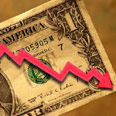
Bold move needed to halt weakning dollar
Interest rates must be slashed in order to close gap between Israel, West
In recent months, the US dollar continues to weaken – not only in Israel, but across the globe. And still, its ongoing drop vis-à-vis the Israeli shekel, which seems to only pick up steam, is impressive even in international standards.
The dollar exchange rate has dropped by almost 12 percent in the past year and by almost 20 percent since it hit a peak five years ago. Meanwhile, the shekel is strengthening not only vis-à-vis the dollar – since last summer, the shekel's value increased also vis-à-vis the euro and the British pound.
The intuitive reaction by many of us is a sense of national pride over the strength of our currency. The days where devaluations of the shekel were commonplace have passed. Yet a more serious examination of the situation reveals several vexing aspects regarding the source of these developments, and mostly regarding their implications.
The Bank of Israel makes sure to maintain a "restrain monetary policy" - that is, it refuses to significantly lower interest rates and continues to maintain a "nominal interest" gap of about one percent between Israeli interest rates and those in the United States.
American interest rates are currently at their highest level in six years, and therefore interest rate decreases in Israel that are undertaken carefully and very conservatively leave rates at a much higher level than what our economy currently needs.
Therefore, it is more important to take note of the real interest rate, which also takes into account inflation gaps between the various economies: While in Israel we have seen negative inflation for several months now, inflation in the US is at an annual level of approximately 2.5 percent.
The real interest rate gap therefore stands at about two percent vis-à-vis the dollar and more than that vis-à-vis the euro. As a result, the cost of credit for the business sector is much higher than that in economies we are competing against.
Time to change direction
Therefore, we must not be surprised that the Bank of Israel's measured and restrained moves have failed to bring about a change in this trend. Another reduction of 0.25 percent is not what the Israeli economy needs – such reduction would not stop the dollar's drop and would not save local industries.
What we need at this time is a massive, significant and bold move in the form of a two percent cut in the interest rate to a level of roughly two percent. Such move would facilitate the development of new employment opportunities, encourage the business sector to boost its investments, and as a result – and this is the most important thing – accelerate economic growth.
At the current pace of economic growth, the gap between us and the Western world keeps on widening. We like to compare Israel to Europe and the US and often talk about welfare services there compared to here and about their standard of living compared to ours.
Yet when we see per capita GDP in Israel about 15 percent lower than that of Europe and about 40 percent lower than that of the US, the road ahead is still long.
In order to ensure a boost in the standard of living, the Israeli economy needs to grow by about six percent annually for the next five years. Therefore, the Bank of Israel governor must change direction, undertake a bold move, and free all of us from the burden of suffocating interest.
Dr. Nathanson is the director general of the "Macro" center for political economics










